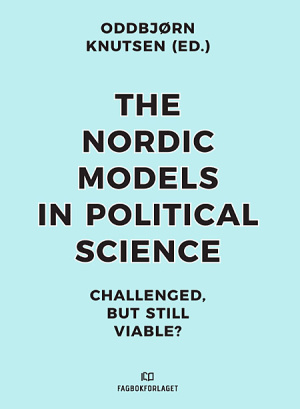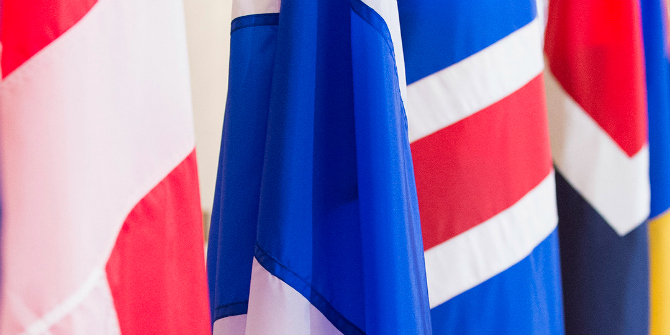In The Nordic Models in Political Science: Challenged, but Still Viable?, editor Oddbjørn Knutsen and contributors provide a useful update on the current state of the ‘Nordic models’. This book is a timely reminder that alternative models of governance exist and will nourish debates about the UK’s future following the Brexit vote to leave the European Union. ‘Where do we go from here?’ is a question on many people’s minds, and exploring the ‘Nordic models’ is not a bad place to start, recommends Mike Pym.
This book review has been translated into Mandarin by James Francis (LN340) and Cong Zijin (Department of Accounting) (Mandarin LN340, teacher Lijing Shi) as part of the LSE Reviews in Translation project, a collaboration between LSE Language Centre and LSE Review of Books. Please scroll down to read this translation or click here.
The Nordic Models in Political Science: Challenged, but Still Viable? Oddbjørn Knutsen (ed.). Fagbokforlaget. 2017.
 The Nordic countries have often been perceived as having a utopian appeal, combining large, supportive states with high participation rates, levels of equality and educational standards as well as a commitment to peaceful progress. Yet, simultaneously viewed as expensive to visit and too liberal for some, they seem to be an anomaly that will inevitably succumb to the international forces with which other nations have grudgingly come to terms. However, such a narrow perspective on the Nordic countries ignores their internal variation and importance as an alternative to parochial views about the way the nation state and government should operate.
The Nordic countries have often been perceived as having a utopian appeal, combining large, supportive states with high participation rates, levels of equality and educational standards as well as a commitment to peaceful progress. Yet, simultaneously viewed as expensive to visit and too liberal for some, they seem to be an anomaly that will inevitably succumb to the international forces with which other nations have grudgingly come to terms. However, such a narrow perspective on the Nordic countries ignores their internal variation and importance as an alternative to parochial views about the way the nation state and government should operate.
This edited collection has been written as a general text for degree-level students and others with an interest in the field. Oddbjørn Knutsen intends the book as a successor to Knut Heidar’s 2004 book Nordic Politics: Comparative Perspectives, but it also usefully updates Mary Hilson’s historical text The Nordic Model: Scandinavia since 1945, which might be more familiar to UK students. Exploring the history, political and administrative arrangements of other countries enables reflection on one’s own society, so the book makes useful reading for anyone interested in challenging their own assumptions, and it greatly benefits from comparative data that supports many of the arguments.
Knutsen, Professor of Political Science at the University of Oslo, edits contributions from a number of distinguished academics into a comprehensive, readable and fascinating exploration of the distinctive traits of the five Nordic countries. These comprise Scandinavia (Sweden, Denmark and Norway), Finland and Iceland, whose histories, whilst diverse, are interrelated enough to be considered a discrete bloc. The volume’s objective is to examine the variation within the ‘Nordic model’ and to consider the degree to which Nordic countries have been influenced by the forces that have generated a degree of convergence in other Western states (13).
The difficulty of a book like this is how to identify its essence from amongst the wide-ranging thoughts and debates about how historical developments have contributed to the nations that we observe today. The culture of Nordic countries and the relationship between the individual and the state seem to be two common and uniting themes that touch upon all areas of discussion in the book and provide a handy lens for its examination.
 Image Credit: Flags of Finland, Norway, Sweden, Denmark and Iceland (ILP Photo Archive CCO)
Image Credit: Flags of Finland, Norway, Sweden, Denmark and Iceland (ILP Photo Archive CCO)
The Nordic nations emerged from centuries of militarism in 1814, reconciled to their position as small and relatively weak states; a smooth transition to democracy followed, completed by the 1920s. These are ‘consensual democracies’, writes Knut Heidar and Bjørn Erik Rasch (105), where multi-party states combine with elections based on proportional representation, generally producing coalition or minority governments that might be considered weak (114). However, Nordic cultures are collaborative and egalitarian, exemplified by high levels of gender equality, corporatism and pluralism, strong local democratic traditions and co-operation in government. Arguably, representation is better in Nordic states than in many other European countries: citizens are able to more creatively influence government and are happier for it.
The welfare state is considered a ‘prime, distinguishing characteristic’ of Nordic countries (219), according to Axel West Pedersen and Stein Kuhnle, where spending has historically been significantly higher than the OECD average as a proportion of GDP. The system is sustained through a common sense of social and moral responsibility, and the redistributive consequences contribute to relatively narrow wealth distribution and high levels of public satisfaction.
Welfare had its ‘Golden Age’ in the 1980s, enabling the Nordic countries to better withstand the impact of the oil price crisis that was so damaging elsewhere (230). However, high unemployment, negative growth and substantial government deficits in the 1990s have led to a more parsimonious approach, where falling net replacement rates mean that pensions in Sweden, for example, are now considered ‘meagre’ (232).
Despite recent reforms of local and regional governments, they continue to play a significant administrative role in the provision of health services in Nordic states. Harald Baldersheim, Lawrence E. Rose and Siv Sandberg identify them as ‘decentralized welfare states’ with a high degree of cooperation between national and local government (193); putting responsibility for healthcare in the hands of local democratic institutions reinforces the connection to citizens. In comparative terms, this arrangement minimises the service integration problems (215) that continue to tax countries like England in terms of health and social care.
The administration of the large state in Nordic countries is also an interesting and related area worthy of comparison with our own system. Implementation of New Public Management (NPM)— devolved decision-making combined with the use of business methods and performance monitoring—was carried out reluctantly in the Nordic countries from the 1980s. Karl Hagen Bjurstrøm and Tom Christensen argue that they were seen as ‘laggards’ (105) in this process, though in their role as ‘reluctant reformers’ of administration (105), Nordic states have fortuitously avoided much of the fragmentation associated with NPM that the UK, for example, is now struggling to overcome. Administrative reform has, nonetheless, taken place in Nordic countries, although the uncomfortable fit of NPM with many features of Nordic society (159) has led to them being overtaken by post-NPM approaches.
More broadly, the Nordic states are facing additional challenges similar to those in many other countries, and economic data confirms a shift towards the OECD average in terms of welfare benefits (233). Pedersen and Kuhnle identify three specific areas of where the welfare state has been challenged since the ‘Golden Age’. First, the demographics of ageing populations have put pressure on public spending that may have a particular impact on Nordic states that have taken on such wide-reaching responsibilities (237). Secondly, economic globalisation has enabled wealth to be easily moved, thereby reducing the state’s ability to collect taxes; and, finally, immigration has challenged the ethnic homogeneity that has been seen by some to bind Nordic societies.
It is easy to understand the appeal of the ‘Nordic models’ and the egalitarian and peaceful states that they have produced. Nordic culture seems to positively encourage political participation and responsibility, and the elements of the models reinforce each other in favourable ways. However, there is no doubt that the Nordic states have and continue to be challenged and not just in the area of welfare. There are challenges elsewhere that show a weakening of ‘corporatism’, increased polarisation and support for the far right as well as falling support for the multi-party democratic system, for example (256). Reassuringly though, Knutsen, in concluding the collection, argues that it still makes sense to talk about distinct and viable ‘Nordic models’. Nordic states remain strongly democratic and equitable societies, and re-examining them here provides much food for thought.
Mike Pym is a Research Associate and PhD student at King’s College London. He is evaluating collaborative administrative models in the NHS in England and the broader changes in administrative methods in the public sector. Read more by Mike Pym.
Note: This review gives the views of the author, and not the position of the LSE Review of Books blog, or of the London School of Economics.
Review translated by James Francis (LN340) and Cong Zijin (Department of Accounting) (Mandarin LN340, teacher Lijing Shi)
 由于很高的选民参与投票率,平等程度,教育水平,加之平衡地发展鼓励,北欧通常被视为“乌托邦”。同时北欧被视为不仅昂贵旅游的国家而且过于自由的国家, 但是除了北欧是世界的例外,可是这些三国家像别国家被世界压力未来必然崩溃。不过对北欧有那样的狭隘观点就让你忽视他们的内部变化和它们以如何国家与政府管制的选项身份。
由于很高的选民参与投票率,平等程度,教育水平,加之平衡地发展鼓励,北欧通常被视为“乌托邦”。同时北欧被视为不仅昂贵旅游的国家而且过于自由的国家, 但是除了北欧是世界的例外,可是这些三国家像别国家被世界压力未来必然崩溃。不过对北欧有那样的狭隘观点就让你忽视他们的内部变化和它们以如何国家与政府管制的选项身份。
这本书是为本科学生和对这方面很感兴趣的人写的。Oddbjørn Knutsen 打算这本书成为Knut Heidar 2014年 Nordic Politics: Comparative Perspectives书的续集,但也是英国学生很熟悉的 The Nordic Model: Scandinavia since 1945书的更新。探索不同国家的历史,政治与行政管理让人反思自己的社会,因此这本书对挑战自己的假定很有用处。这本书的优点在于大多论点都有比较数据的支持。
奥斯陆大学的政治学教授Knutsen全面综合著名学者对北欧五国特性的探索,整本书编辑得易读与有趣。包括北欧三国(瑞典,挪威与丹麦),芬兰语冰岛。它们的历史虽然各色各样,但是因为有密不可分的文化可算是一个特别地区。这部书的目标是分析北欧模式之间的变异,并考虑在西欧国家内收敛程度的势力如何牵动了北欧(13页)。
这样一本书的困难之处在于,如何从有关历史发展如何对我们今天看到的这些国家作出贡献的广泛思想和辩论中确定其本质。北欧国家的文化和个人与国家的关系似乎是两个常见的、统一的话题,触及到了这本书讨论的方方面面,并为其审查提供了一个方便的角度。
 Image Credit: Flags of Finland, Norway, Sweden, Denmark and Iceland (ILP Photo Archive CCO)
Image Credit: Flags of Finland, Norway, Sweden, Denmark and Iceland (ILP Photo Archive CCO)
北欧国家诞生于1814年,是由一些因认清了自身弱小地位而决定联合的军国主义国家组成;随后北欧开始向民主过渡,这一过程最终在20世纪20年代完成。这被称为“共识民主国家”,Knut Heidar 和 Bjørn Erik Rasch (105页)这样写道,由多党制国家经过以比例代表制为基础的选举后组合而成,通常会产生可能被认为软弱的联合政府或少数党政府(114页)。然而,北欧文化是合作和平等的,例如高度的性别平等、社团主义和多元主义、强大的地方民主传统以及政府合作。可以说,比起其他欧洲国家,代表制在北欧可以得到更好的实施:公民能够更有创造性地影响政府,并因此而更快乐。
根据Axel West Pedersen 和 Stein Kuhnle,福利国家是北欧国家“主要的,独特的特点”(219页),这些国家的福利支出占GDP的比例历来明显高于OECD国家的平均水平。这一制度是通过社会和道德责任的共识来维持的,再分配使得财富分配相对狭窄,并带来了较高的公众满意度。
福利制度在20世纪80年代达到了“黄金时代”,使北欧国家能够更好地抵御对其他地区造成巨大破坏的油价危机的影响(230页)。然而,20世纪90年代的高失业率、负增长和巨额政府赤字导致政府开始节约开支,净替代率下降,以瑞典为例,该国的养老金现在被认为是“微薄”的(232页)。
尽管地方和区域政府最近进行了改革,但它们在北欧国家提供健康服务方面仍然发挥着重要的行政作用。Harald Baldersheim、Lawrence E.Rose和Siv Sandberg认为在国家和地方政府之间开展了高度合作的“分散的福利国家”(193);将医疗保健责任交给地方民主机构的做法加强了与公民的联系。相对而言,这种安排将服务整合问题(215)降至最低,“而迄今为止,这些问题仍旧导致英国等国家在健康与社会保健方面征税”
北欧国家的大国管理也是一个有趣的相关领域,值得与我们自己的体制进行比较。20世纪80年代起,北欧国家不情愿地实施了新公共管理(NPM),使用商业方法与绩效监控相结合的方式进行决策。Karl Hagen Bjerström和Tom Christensen认为,在这一过程中,他们被视为“落后者”(105人),尽管在作为不情愿的政府改革者的角色下(105),北欧国家偶然地避免了许多与核电站有关的分裂,例如,英国现在正在努力克服这一问题。尽管如此,北欧国家已经进行了行政改革,尽管NPM在北欧社会的很多特征下的不适应性 (159) 导致它们被新产品管理方法所取代。
更广泛地说,北欧国家面临着与许多其他国家类似的其他挑战,经济数据证实在福利福利方面,北欧国家向经合组织平均水平的转变(233)。Pedersen和Kuhnle指出了自“黄金时代”以来福利国家受到挑战的三个特定领域。首先,人口老龄化给公共支出带来了压力,这可能对承担如此广泛责任的北欧国家产生特殊影响(237)。第二,经济全球化使财富易于转移,从而降低了国家征税的能力;最后,移民挑战了民族同质性,有些人认为这种同质性凝聚了北欧社会。
很容易理解“北欧模式”和它们所产生的平等和平国家的吸引力。北欧文化似乎积极鼓励政治参与和责任感,这些模式的要素以有利的方式相互加强。然而,毫无疑问,北欧国家已经并将继续受到挑战,不仅仅是在福利方面。其他地方的挑战表明“社团主义”的削弱、右派的偏激程度和支持的增加以及对多党民主制度的支持下降,等等(256)。不过,让人放心的是,克努特森在总结这本书时认为,谈论独特而可行的“北欧模式”仍然是有意义的。北欧国家仍然是强大的民主和公平的社会,对他们的重新审视仍然是值得深思的.








2 Comments